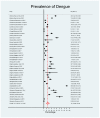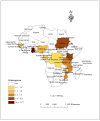Seroprevalence of Dengue and Chikungunya Virus Infections in Children Living in Sub-Saharan Africa: Systematic Review and Meta-Analysis
- PMID: 37892325
- PMCID: PMC10605353
- DOI: 10.3390/children10101662
Seroprevalence of Dengue and Chikungunya Virus Infections in Children Living in Sub-Saharan Africa: Systematic Review and Meta-Analysis
Abstract
Dengue and chikungunya viruses are frequent causes of malarial-like febrile illness in children. The rapid increase in virus transmission by mosquitoes is a global health concern. This is the first systematic review and meta-analysis of the childhood prevalence of dengue and chikungunya in Sub-Saharan Africa (SSA). A comprehensive search of the MEDLINE (Ovid), Embase (Ovid), and Cochrane Library (Wiley) databases was conducted on 28 June 2019, and updated on 12 February 2022. The search strategy was designed to retrieve all articles pertaining to arboviruses in SSA children using both controlled vocabulary and keywords. The pooled (weighted) proportion of dengue and chikungunya was estimated using a random effect model. The overall pooled prevalence of dengue and chikungunya in SSA children was estimated to be 16% and 7%, respectively. Prevalence was slightly lower during the period 2010-2020 compared to 2000-2009. The study design varied depending on the healthcare facility reporting the disease outbreak. Importantly, laboratory methods used to detect arbovirus infections differed. The present review documents the prevalence of dengue and chikungunya in pediatric patients throughout SSA. The results provide unprecedented insight into the transmission of dengue and chikungunya viruses among these children and highlight the need for enhanced surveillance and controlled methodology.
Keywords: Sub-Saharan Africa; chikungunya virus; dengue virus; prevalence; systematic review.
Conflict of interest statement
The authors have no relationship, financial or otherwise relevant to this article, to disclose.
Figures







References
-
- World Health Organization Disease Outbreak News: Geographical expansion of cases of dengue and chikungunya beyond the historical areas of transmission in the Region of Americas. [(accessed on 23 March 2023)]. Available online: http://www.who.int/emergencies/disease-outbreak-news/item/2023-DON448.
Publication types
LinkOut - more resources
Full Text Sources
Research Materials

